Vintner Stories - September 27, 2023
Austria – Craft Wine Hub
This content was produced in collaboration with Austrian Wine with intention to promote wine craft in Austria
Written by
Aleks Zecevic
Austria – Craft Wine Hub
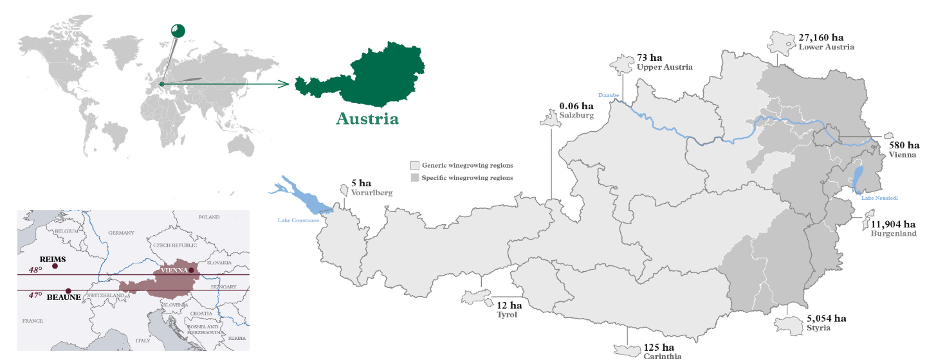
"©Austrian Wine"
At first glance, Austria’s well preserved cultural and historical heritage might make it seem like the country is stuck in its old ways. However, appearances can be deceiving, at least when it comes to its viticulture. The country’s wine scene is very dynamic, and ever-changing. It is famous for the craftsmanship of its vintners and their environmental consciousness. It is primarily for this reason that Vintners.co has partnered with the Austrian Wine Marketing Board to build this page. Craft is at the heart of our platform, and we are proud to support the growth of independent growers.
Austria is home to many and is one of the leaders of the world organic viticulture. According to the Federal Ministry for Agriculture, Forestry, Regions and Water Management of Austria, 22 percent (a little under 10,000 hectares) of the country’s total area under vines is already being cultivated organically. Furthermore, 15 percent (a little under 1,500 hectares) of all organically cultivated vineyards are farmed biodynamically. And finally, 8,808 ha (20 %) of the area under vines has been certified as sustainable, while the rest is predominantly being cultivated according to the precepts of integrated viticulture, states the Austrian Winegrowers’ Association. These numbers put Austria at the top of organic production by total viticultural area.
Further, Austria is home to a number of environmental organizations that promote green viticulture. Most importantly, there is Sustainable Austria, a certification system introduced in 2015, the system currently offers winegrowers the tools to gauge their own ecological impact and provides specific guidelines for compliance and improvement.
Overlooked Diversity
There are a few countries in the world that can brag about their diversity, like Austria can. The central European country is almost five times smaller than California, yet it is able to produce a vast range of styles – from light and crisp to heavily macerated whites, rosés; traditional sparkling wine called sekt and mouthwatering pét-nat; light and heavy rosés; and finally, reds that range from ultra-light to rich and extracted – Austria really has it all.
The diversity comes at an even bigger surprise when you take into consideration that more than a half of the country’s total area is not suitable for winegrowing. Austria’s winegrowing area comprises 44,728 hectares (110,525 acres), which is only 0.5% of the country's total area. Compare this to France where 1.4% of total is comprised of vineyards.
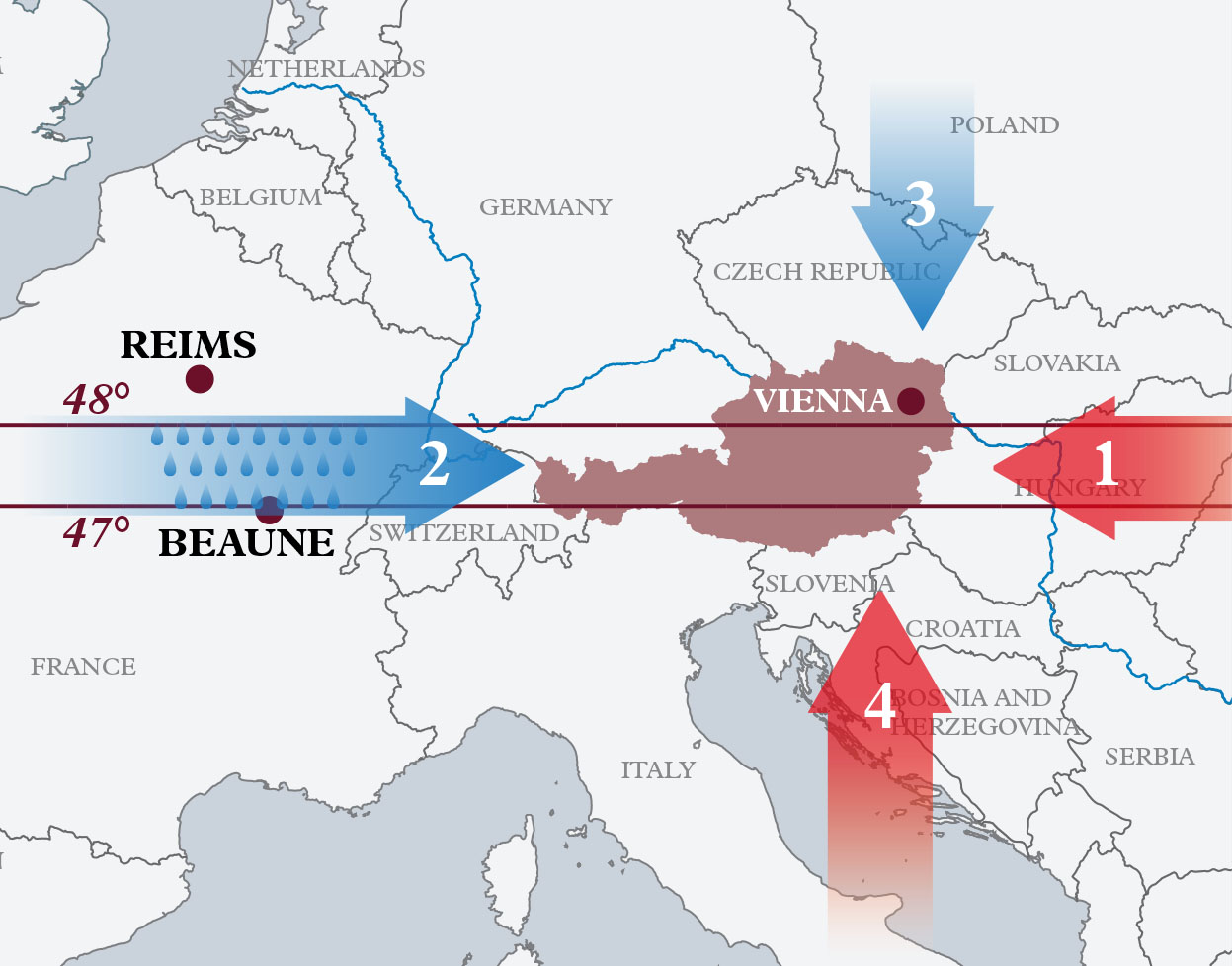
"©Austrian Wine"
This is because of the high altitude and Alpine influence in the west of the country. But it is exactly the influence of this mountainous area that collides with the warm Pannonian climate in the east of the country, as well as the influences of the Adriatic from the south and cool winds from the north, which creates such diversity. Additionally, the Danube represents yet another important factor, as it creates a significant diurnal temperature range.
The altitude, slope, and proximity to a range of different landscapes influences the special features of the vineyards. This complex topography has created an incredible array of different soils, but also various microclimatic pockets. Thanks to this diversity, Austria successfully grows many different grape varieties, both indigenous and international.
The Soil
In addition to climate, the diversity of Austria’s soils adds to the range of wines produced. The impact of soil in winegrowing has been an important topic for many wine lovers. Their composition determines water, air and heat retention, the availability of nutrients, how deep the vine roots can penetrate to find water, and more. This further helps decide which grape varieties are most suitable for given soils, how they should be planted and trained, and most importantly, they impact the wine qualities.
Austria features an immense diversity of different soils. Its location is at the crossroads of movements of tectonic plates, where some mountains rose, others lowered, and oceans retracted. This created a multilayered soil composition of Austria, which spreads from west to east, contributing to many different types of soil from south to north.
The main soils found in Austria are loess, calcareous clay and limestone soils, schist, slate, granite, and volcanic soils. Combined with the country’s equally diverse climate, this means that Austrian wine can differ even if made from vineyards that are very close to each other. However, one distinctive quality binds them all, and that is the constant tension between acidity and ripeness.
The Grape Varieties
As previously mentioned, Austria is home to many different grape varieties. However, there are 40 that are officially approved. Certain grapes are reserved for the production of Qualitätswein or quality wine (wines with the specific designation of origin), Prädikatswein (Qualitätswein produced from grapes that are harvested using special techniques once they have reached a specific degree of ripeness) and Landwein (wines of lowest denomination). There are 26 varieties approved for production of white wine, and 14 approved for reds.
Globally, Grüner Veltliner has cemented itself as the country’s signature variety. This white variety is indigenous to Austria, and it accounts for almost one third of Austria’s area under vine. There are another 10 native grape varieties, and they include:
White: Frühroter Veltliner, Neuburger, Rotgipfler, Roter Veltliner, Sylvaner, Zierfandler
Red: Blauer Portugieser, Blauer Wildbacher, Blaufränkisch, Sankt Laurent
Austria also offers a range of international varieties such as: Riesling, Pinot Blanc, Chardonnay, Muskateller, Traminer, Pinot Noir, Merlot, Cabernet Sauvignon and Syrah.
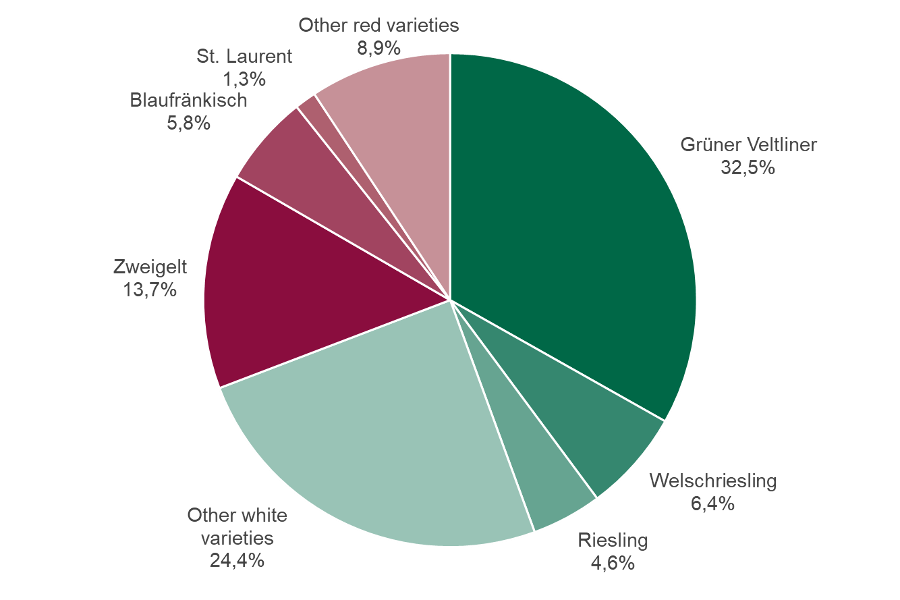
"©Austrian Wine"
Many of these grape varieties have the same parents: Traminer and Heunisch. Traminer, one of the oldest European varieties, was supposedly selected from wild vines that grew during antiquity. Heunisch is the name of a family of grape varieties that the Hungarians have brought to Austria, where these grapes spread quickly. At least 75 of varieties known today have Heunisch in their parentage, Chardonnay and Riesling being two examples.
In addition, there are also new cultivars and PIWI (fungal resistant) varieties, which result from the intentional crossing of two or more grape varieties. The goal is to create a “superior” new variety that carries positive characteristics of its parents, while diminishing the negatives. In case of PIWI’s, this is also true, with the added quality of being partially resistant to fungal diseases, meaning they need to be sprayed less (many growers see a great potential for sustainable viticulture in the future with these varieties).
Despite intense efforts, however, these processes have only achieved partial success. Cross-cultivating vines is both time-consuming and cost-intensive. In Austria, new cultivars are bred at the research centre of the Höhere Bundeslehranstalt für Wein- und Obstbau (Federal College for Viticulture, Oenology and Fruit Growing) in Klosterneuburg.
These varieties are:
White: Müller-Thurgau, Muskat-Ottonel, Scheurebe, Jubiläumsrebe, Goldburger
White PIWI: Blütenmuskateller, Muscaris, Souvignier Gris
Red: Blauburger, Zweigelt
Red PIWI: Rathay, Roesler
Important Grape Varieties
Grüner Veltliner
Grüner Veltliner is the most important indigenous grape variety in Austria and the one that the country is most associated with worldwide. It is also the most widely planted variety in the country. Its parentage is not entirely confirmed, but it is most likely that it was derived from a crossing between Traminer and an old variety discovered in Sankt Georgen in Burgenland.
Grüner started spreading during the 1950s when Lenz Moser’s high vine training system was introduced, which allowed for easier farming with the help of machinery. Today, this variety is planted throughout Austria, but most plantings are in Niederösterreich (Lower Austria) and northern Burgenland. This is where Grüner Veltliner is planted in the most renowned sites and used to produce wines of highest quality, which display the typical characteristics of their origins.
Thanks to this privilege and its ability to display terroir characteristics, it achieved international recognition and popularity at the end of the 20th century. Most wine professionals would agree that Grüner wines have a great ability to develop and get better with age.
However, most vintners would also agree that it is a variety that requires special conditions and a lot of work in the vineyard. It is high yielding, so crop management is required to achieve quality. It is also sensitive, and many growers will tell you that it is a very delicate, even feeble grape in comparison to Riesling, as it doesn’t grow well in very poor soils, dry areas and very cool sites. It is also very susceptible to Peronospora, Pseudopezicula tracheiphila and chlorosis. For this reason, Grüner is normally planted in sites that have a bit more topsoil. It grows especially well in loess soils, but examples grown in limestone soils can be very profound as well.
Riesling
Along with Grüner, Austria became known internationally thanks to its high-quality wines made from Riesling, as well. This noble white variety is mostly grown in the regions along the Danube, although there are plantings in other regions as well, but to a smaller degree.
It is thought to historically derive from a wild vine that flourished in the Rhine Valley in Germany and has been selected and developed over the years. It was brought from the Rhine to the Danube in Austria where it’s planted in sites that are not that suitable for Grüner, but because of Riesling’s resilience and late-ripening nature, it grows very successfully there. It can be found in many premium vineyard sites, especially in the wine growing regions Wachau, Kremstal, Traisental, Kamptal as well as Wien (Vienna), Wagram and Weinviertel. The vineyard area for Riesling increased steadily between 1999 and 2020.
Despite its advantages, Riesling also requires a lot of attention in the vineyards, because it is sensitive to grape stalk necrosis, stalk rot and botrytis (which is not very desirable for producing dry wines).
Chardonnay (known as Morillon in Styria)
Chardonnay only gained in importance throughout Austria at the end of the 20th century, although it had already become established as a significant variety in Steiermark before then. It most likely arrived with the Cirstecians, but back then it was often confused with Pinot Blanc.
In Styria, however, Chardonnay became basically a native variety known as Morillon. In fact, until about 50 years ago, Styrians didn’t even realize that Morillon is actually Chardonnay. The theories of how Morillon became a Styrian signature variety, and its origins are not relatedto the Cistercians and the rest of Austria. Its local name indicates that it arrived in Styria separately, as the name Morillon is not used in any other Austrian regions.
Namely, it was thanks to Archduke Johann of Austria (1782– 1859) who sent his men to bring back vine cuttings from France in an effort to improve the quality of wines produced in the area. His farmers planted over 400 varieties as a test, most of which were forgotten, with only Morillon and Sauvignon Blanc remaining.
Styrian Morillon offers a unique expression of the grape, and most experts would agree that Morillon without Styria is just Chardonnay.
Sauvignon Blanc
As mentioned above, Sauvignon Blanc most likely came to Austria with Chardonnay (Morillon) in the early 19th century. At this time, it was known as Muskat-Sylvaner, but this name is no longer permitted to avoid confusion, as the qualities of Sauvignon are unlike those of both Muskat and Sylvaner grapes.
Just like Morillon, Sauvignon Blanc has adopted in Styria so well that many locals consider it their native variety, despite it being sensitive to fungal diseases, which are an issue in the vineyards of this rather wet and humid region. Both downy mildew (peronospora) and powdery mildew (oidium) can be a problem for Sauvignon, but with hard work in the vineyards even growers who don’t use synthetic sprays manage the diseases well.
Today, more than half of total Sauvignon Blanc plantings in Austria are in Styria, but there are significant percentages in both Lower Austria and Burgenland. It is a mid- to late-ripening variety that can produce world-class wines with good vineyard management.
Zweigelt/Rotburger
Zweigelt, also known as Rotburger, was created in the 1920's by Professor Fritz Zweigelt. It is a crossing between Blaufränkisch and St. Laurent. This grape only started getting recognition after the Second World War with the advances in technology and changes in viticulture. Nowadays, Zweigelt is the most widespread red wine variety in Austria and can be found in suitable sites in all wine-producing regions.
Lower Austria has more than a half of total plantings of Zweigelt, while Burgenland has a bit more than a third. This widespread distribution happened thanks to the vintners Lenz Moser, who used it in his high vine training system, which allows the use of tractors and machines. Thanks to Zweigelt’s high-yielding nature and these farming techniques, the grape became very popular among Austrian growers. However, the quantity and quality don’t go hand in hand, so its reputation is not the best.
However, when taken care of carefully, Zweigelt can give juicy, medium-bodied wines that are easy to drink and are perfect for everyday enjoyment. Still, the style spectrum is wide, from heavily extracted and oaked wines to super light, almost rosé-like reds. In Carnuntum Zweigelt is the important part of the blend in the region’s Rubin Carnuntum brand.
Blaufränkisch
This traditional Austrian variety is a cross between Sbulzina and Weißer Heunisch. Blaufränkisch, or Blau as locals call it, was the noble grape of the Austro-Hungarian Empire (1867–1918). Its suffix signals its pedigree, as, at the time, collectively, noble grapes were referred to as “Fränkisch.”
Blaufränkisch was previously widely planted throughout the Monarchy, and in Austria it is mostly found in the wine-growing regions of northern, central and southern Burgenland, especially in Mittelburgenland, which is also called Blaufränkischland.
It is the flagship variety in Südburgenland (Eisenberg), Mittelburgenland (known as “Blaufränkischland”) and Leithaberg. It is also a key variety in Carnuntum. These regions all produce DAC wines with typicity of origin. This variety is very demanding in terms of where it grows. It is especially prone to coulure if the weather is cool during the flowering phase.
Sankt Laurent
St. Laurent belongs to the Pinot family, and the synonym Pinot St. Laurent suggests a pinot seedling. During a more quality orientated thinking in recent years, the variety has experienced a revival in all wine-producing regions. However, it is found mainly in the Thermenregion and northern Burgenland. The total area under this variety increased significantly between 1999 and 2020.
These vines are considered challenging to grow, which is why they have not always been popular. They need a good vineyard with soils in which they can root deeply. They are sensitive during the flowering period, easily harmed by late frosts and produce low, irregular yields.
Wine Regions
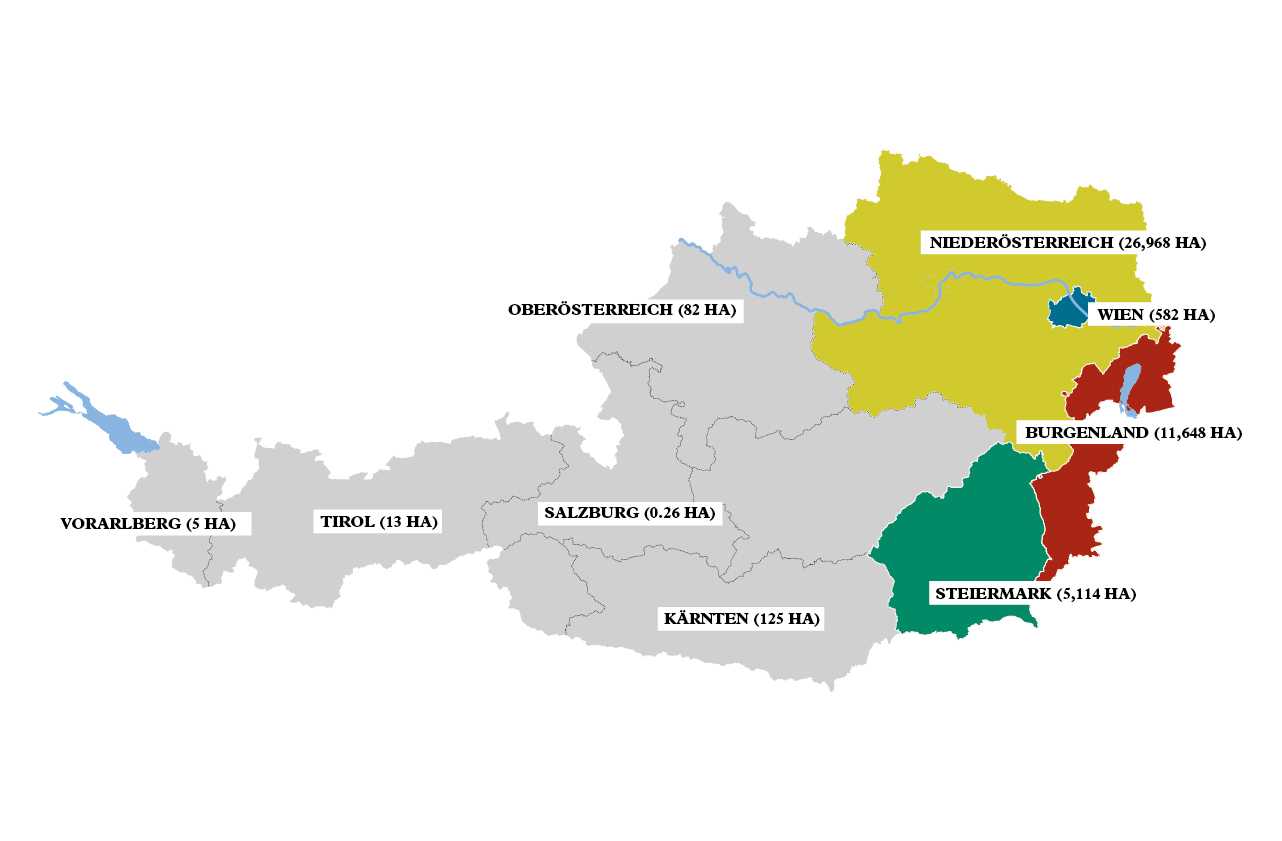
"©Austrian Wine"
The federal states of Niederösterreich (27,074 ha), Burgenland (11,772 ha) and Steiermark (5,086 ha) are defined as generic winegrowing regions, there are also 17 specific winegrowing regions, including Vienna, or Wien (575 ha) and the area Bergland with five winegrowing regions (Kärnten, Oberösterreich, Salzburg, Tirol, Vorarlberg).
Apart from the generic wine regions, each of them has more specific regions within, which further define quality and establish rules and typicity of a given place. Below, we talk about these in more detail.
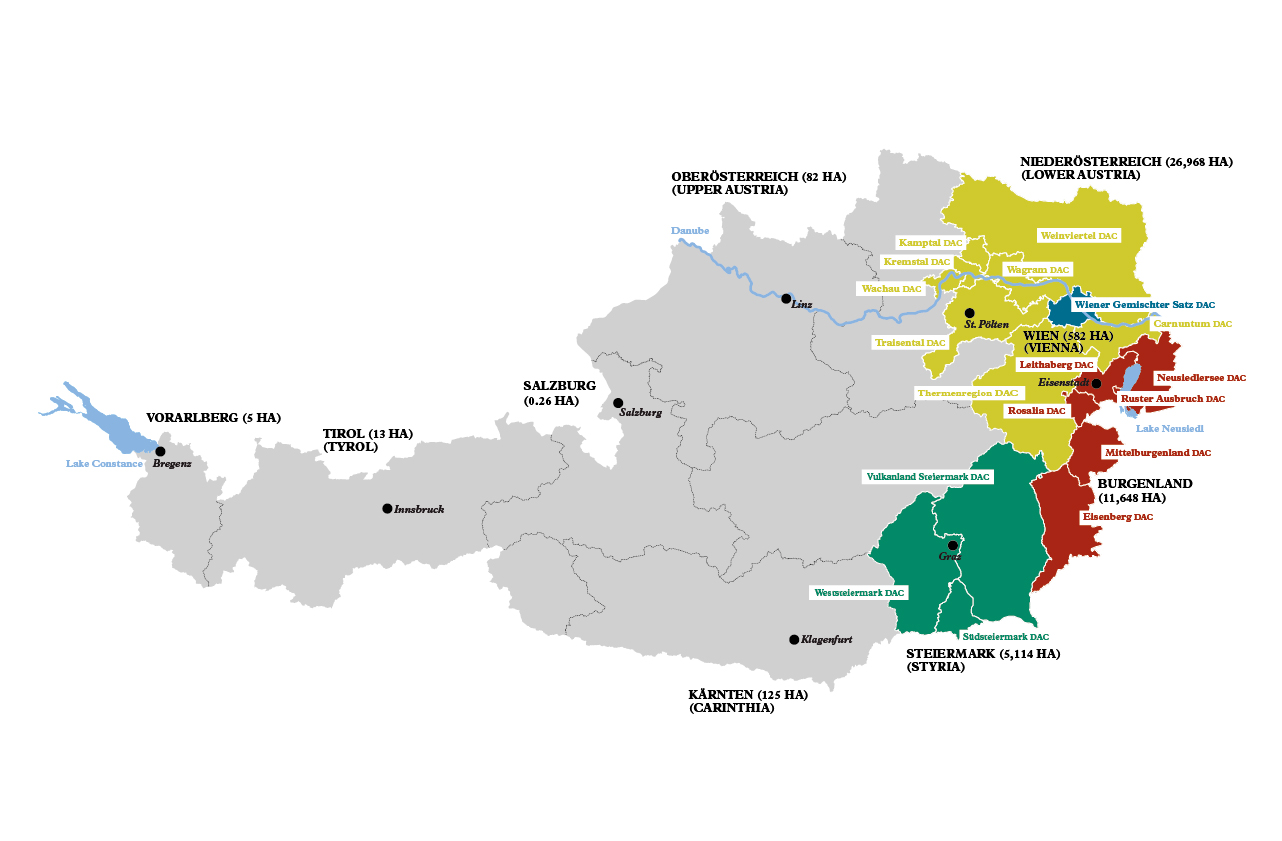
"©Austrian Wine"
Niederösterreich (Lower Austria)
Niederösterreich (Lower Austria) is Austria’s largest winegrowing region on quality level. It is so vast and diverse that sometimes it is puzzling why so many different subregions have been clumped together. Indeed, Lower Austria is home to eight specific wine-growing regions, from Wachau in the west to Carnuntum in the east.
It would be fair to say that Grüner Veltliner dominates the region. While Riesling, Roter Veltliner, Chardonnay and Weissburgunder also contribute to some of the main white wine specialties, for red wines Zweigelt, and to lesser degree Blaufränkisch, lead the way. The reds are particularly found in Carnuntum. The specific sub-regions have their own rules for permitted varieites and any wines that don’t correspond to those rules can be marketed under the more generic “Niederösterreich” designation of origin.
Carnuntum
The Carnuntum winegrowing region is the most eastern stretch of Lower Austria, lying on the very border with Slovakia. The vineyards are situated south of the Danube across three hilly areas: the Leitha Range, the Arbesthaler Hills and the Hainburg Mountains. The region is characterized by the Pannonian climate with hot summers and harsh winters, which is perfect for creating elegant red wines, but also interesting white wines. The main soil types are loess, loam, gravel, sand and limestone.
Zweigelt and Blaufränkisch are the main varieites of the Carnuntum DAC, although cuvée blends may contain up to a third of other red allowed grape varieties, such as Sankt Laurent, Cabernet Sauvignon or Merlot. For white wines Chardonnay, Pinot Blanc and Grüner Veltliner are permitted as regionally typical monovarietal wines. As with red DAC wines, white cuvée blends may also contain up to a third of other white Qualitätswein grape varieties.
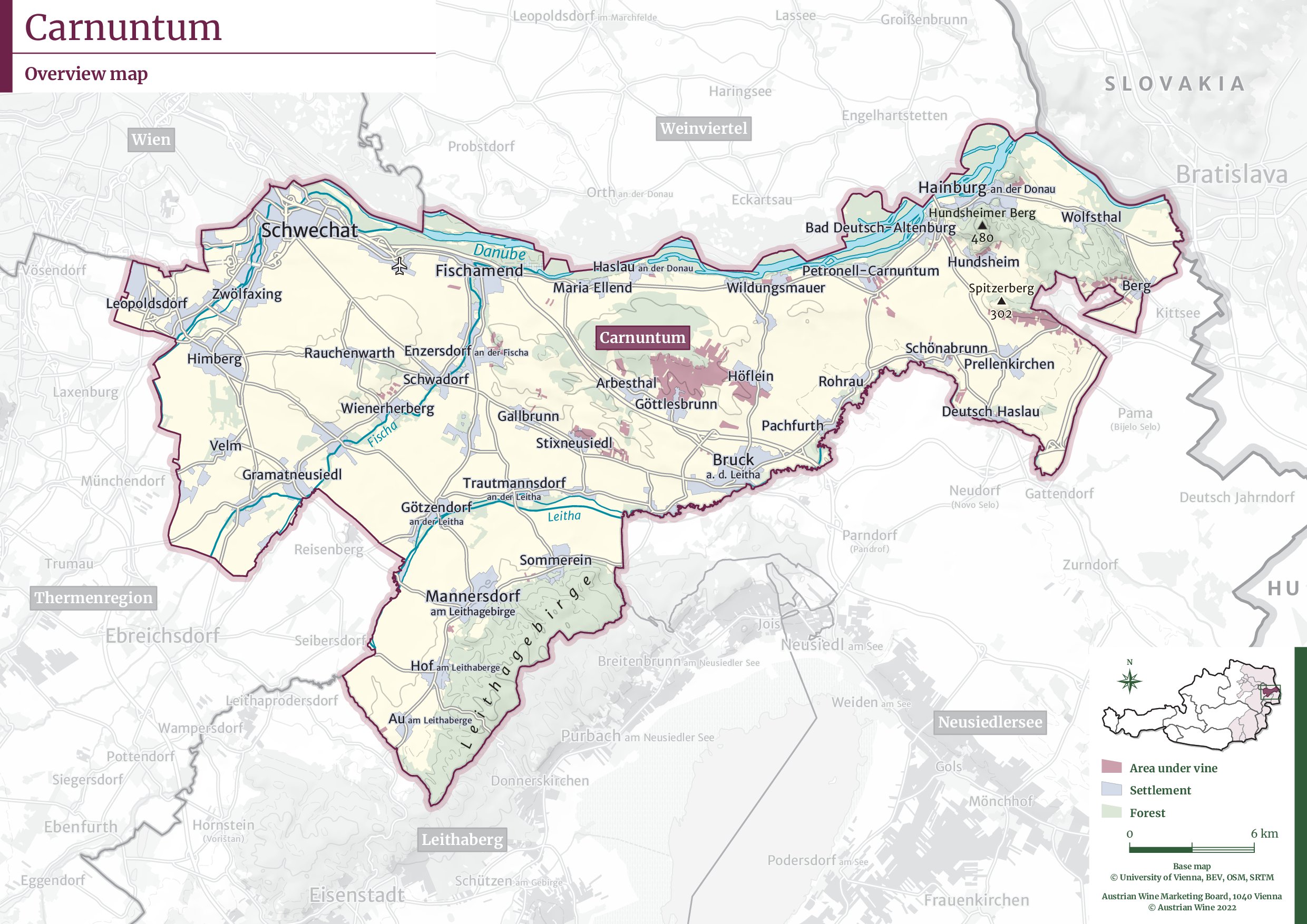
"Carnuntum Map (©Austrian Wine)"
Kamptal
Kamptal is named after the Kamp river, a tributary to the Danube. Together, the two rivers, as well as ancient seas and volcanoes, produced different rock formations, that can be found in the region, including loess, gravel, red sandstone and conglomerate. This contributes to the individuality of the Kamptal
The Kamptal vineyards are mainly planted to two distinct types of soil – sandstone with volcanic elements and loess with loam. The former is perfect for Riesling, while the latter suits Grüner Veltliner. These are the main varieties of the Kamptal DAC. Other varieties in the region are used for the Niederösterreich designation and these include Zweigelt and Burgundian varieties mainly.
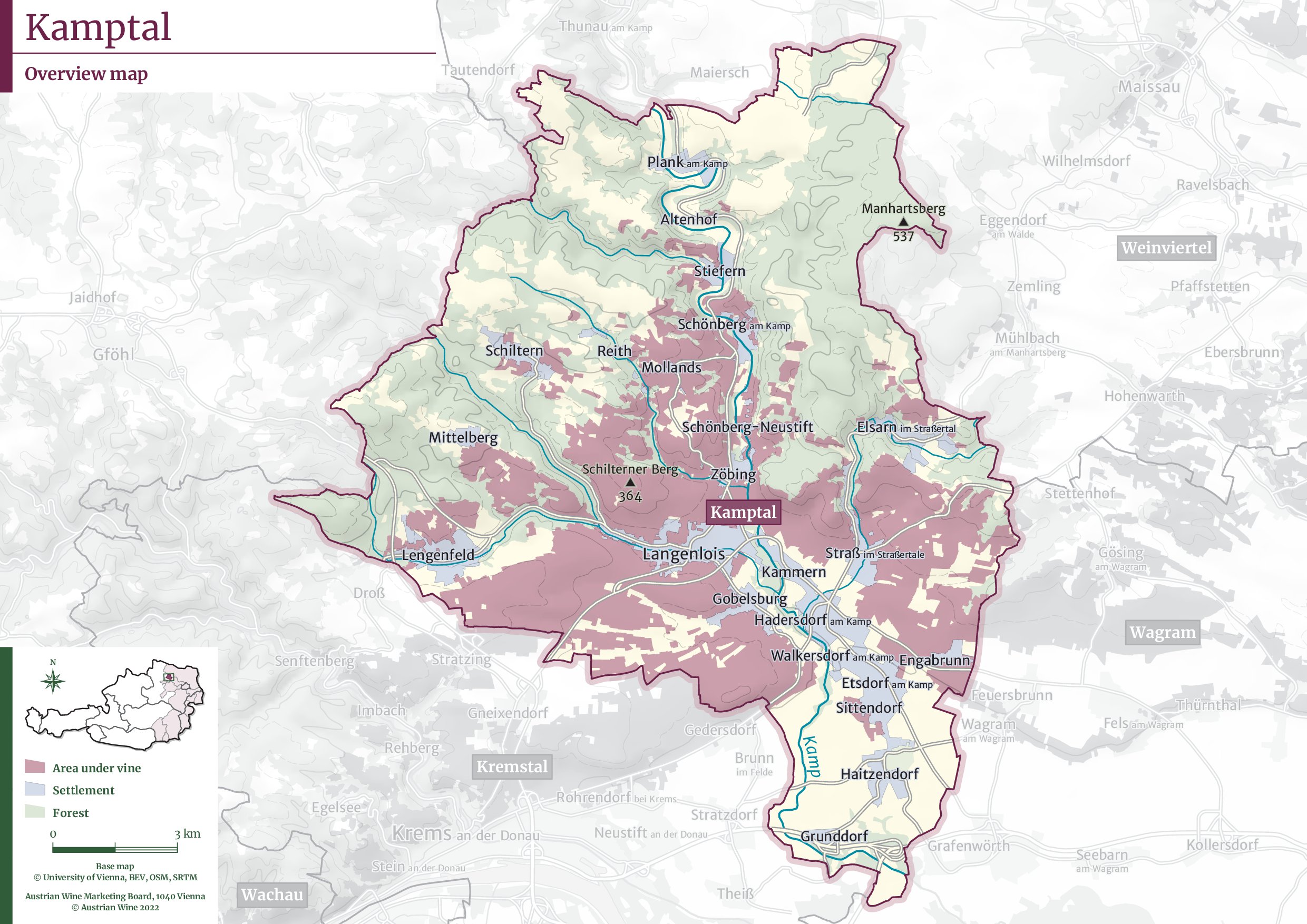
"Kamptal Map (©Austrian Wine)"
Kremstal
Kremstal is easily the main town of Lower Austria west of Vienna. Its viticultural history is rich and today, Krems hosts a world-famous wine university. It shares similarities with both the neighboring Kamptal and Wachau, with similar climatic tension and soil types. To the west poor, rocky soils are perfect for Riesling vineyards, while in the east loess takes over as this becomes the Grüner Veltliner country.
Just like in Kamptal, Kremstal DAC is formed with these two varieties, while the Burgundian varieties, both red and white can be labeled under Niederösterreich designation. Many famous vineyards, such as Pfaffenberg, Kögl, Wachtberg, Sandgrube, Pellingen, Gebling, Spiegel and Steinbühel, produce distinctive Riedenwein that are full of distinct character.
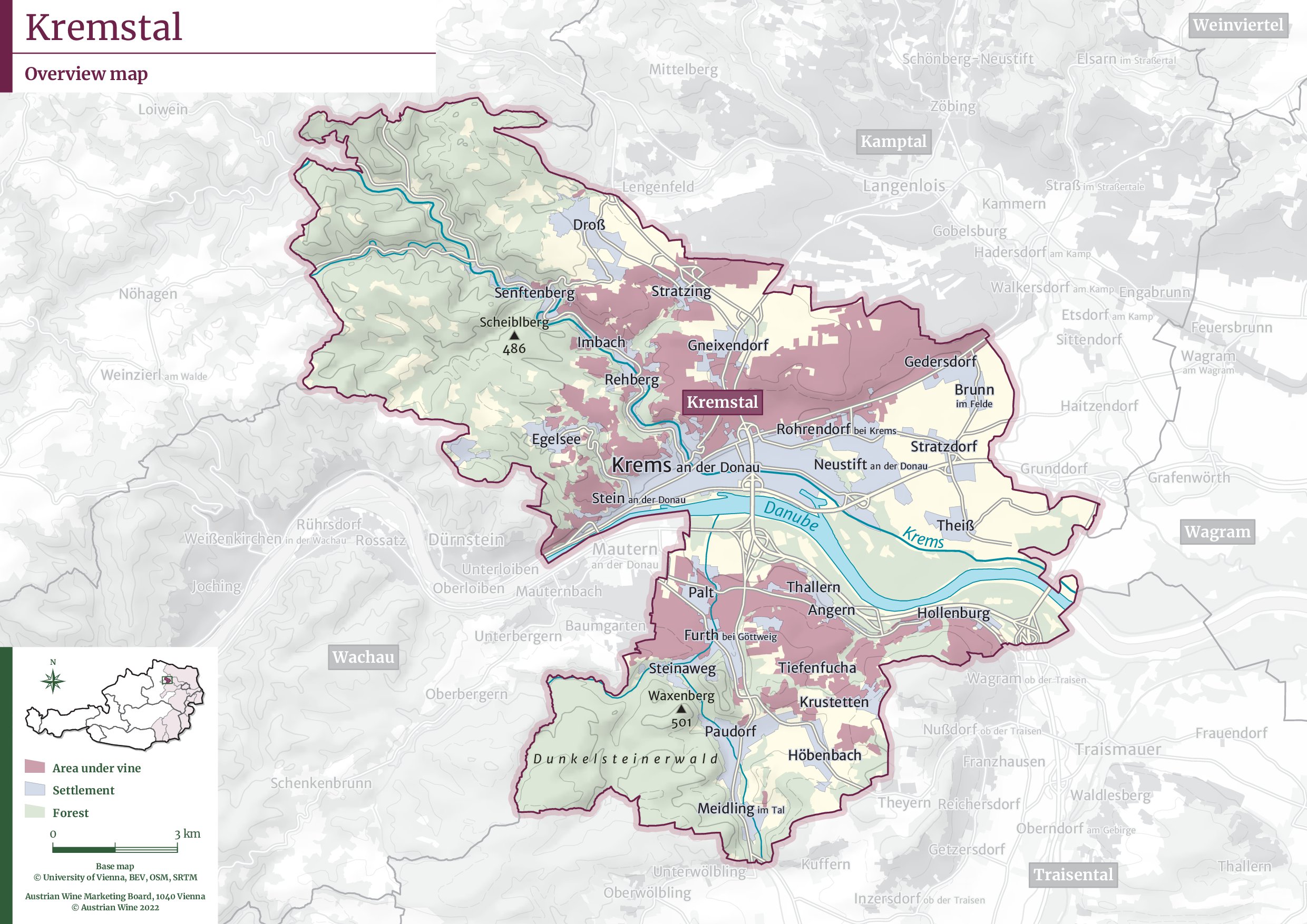
"Kremstal Map (©Austrian Wine)"
Thermenregion
Named after the sulfur-rich hot springs (or therme), Thermen region has a rich viticulture history, dating back more than 2,000 years when the Romans introduced it to the region. In the Middle Ages, the Cistercian monks brough the region to the peak, arranging the vineyards and the villages similarly to Burgundy.
The Cistercians recognized the benefit from the Pannonian climate with hot summers and dry autumns, not to mention the abundance of sunshine, coupled with constant wind, which is great for keeping the grapes healthy. Soils are predominantly loamy here, with gravel and sand, and high lime content. \
The region is quite diverse, which is shown in its DAC rules, which allow grapes like Portuguiser, Rotgipfler, Zierfandler (Spätrot) and Neuburger, in addition to Zweigelt, Burgundian varieties and Sankt Laurent. Even sweet wines are permitted like Auslese, Beerenauslese and Trockenbeerenauslese.
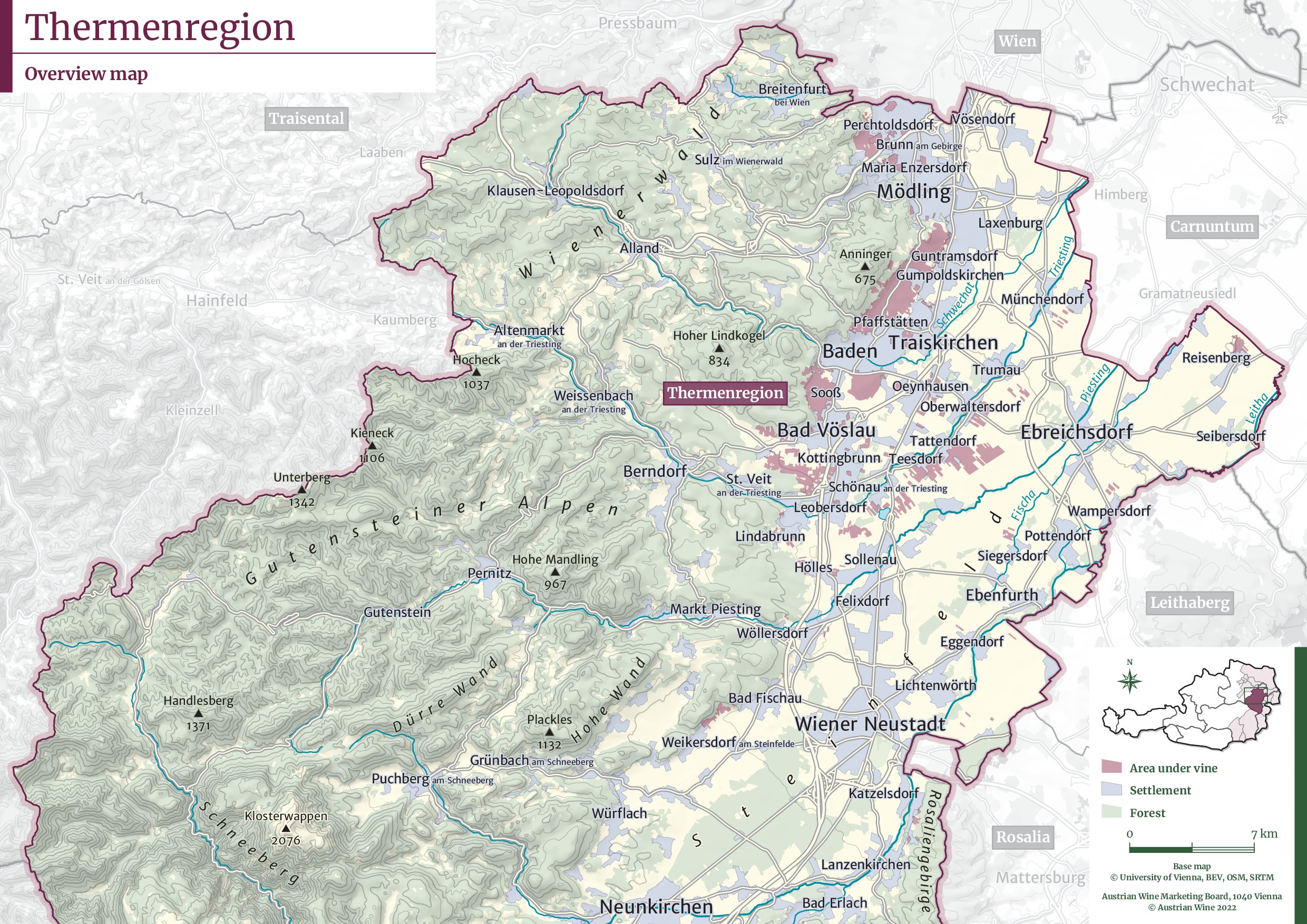
"Thermenregion Map (©Austrian Wine)"
Traisental
Traisental has been recognized as its own wine region only since the mid-1990s and is thus one of the youngest wine regions in Austria. is one of the youngest winegregions in Austria, having only existed in its present form since 1995. With its beautiful rolling hills and small vineyards, Traisental is a perfect spot for young winemakers.
The most prominent soil here is the coarse, calcareous dolomitic gravel, which originated from the rising of the Calcareous Alps and was deposited by the ancient river Traisen roughly 16 million years ago. In this terroir, Grüner thrives, and thus it represents roughly 60 percent of the vineyard area. The second most-widely planted variety is Riesling, with only 6 percent.
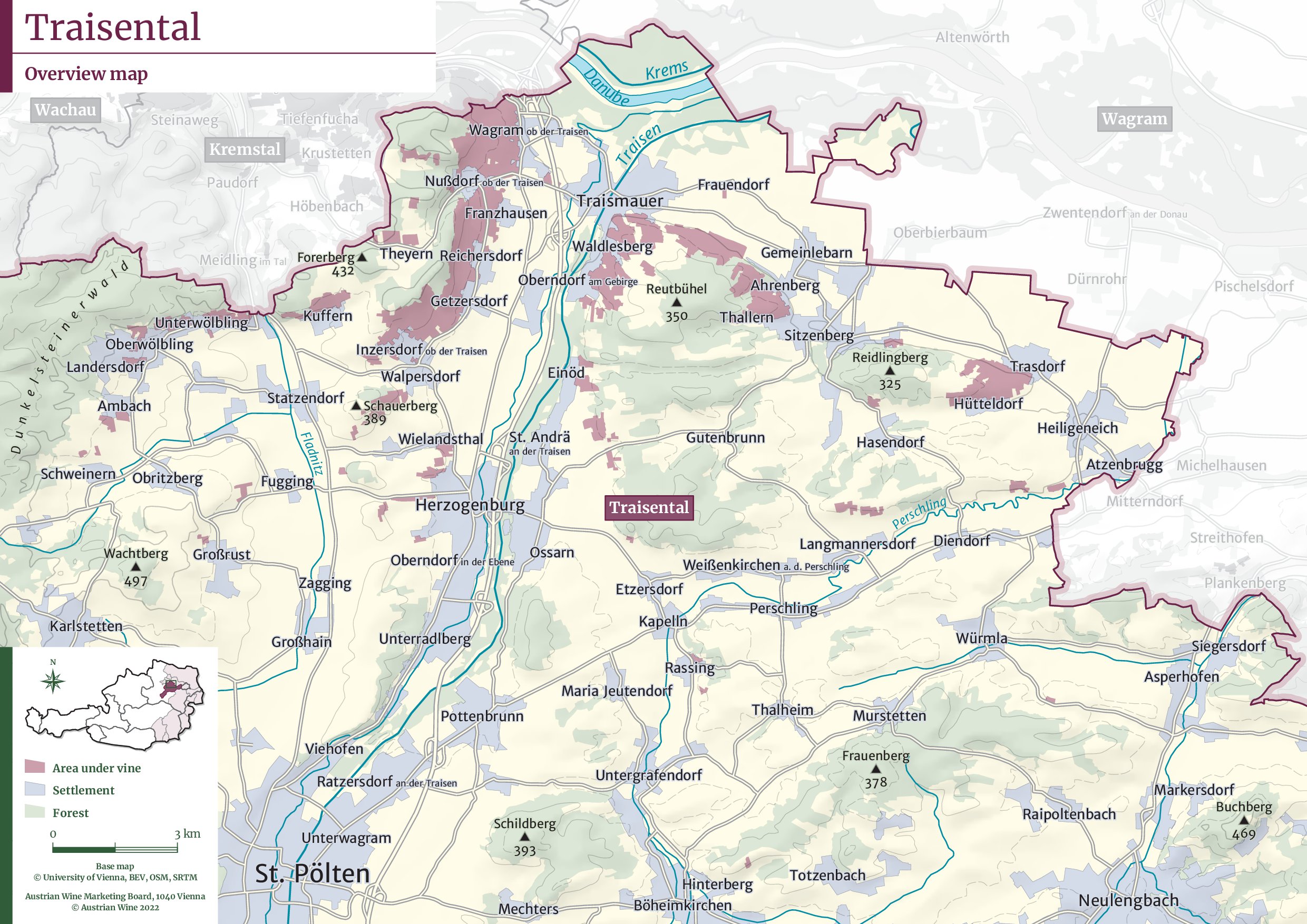
"Traisental Map (©Austrian Wine)"
Wachau
Wachau is probably the most famous wine region in Austria and its beauty can maybe only be challenged by that of Styria. However, while Styria is mostly shaped by nature, Wachau combines the power of the Danube with human craft. The viticultural landscape is shaped by its geological terrain and its stone terrace walls, which were constructed in the Middle Ages under the governance of Bavarian monasteries. These hills would otherwise be impossible for farming. For this reason, Wachau is included in the UNESCO World Heritage list.
Wachau shares similar climate to Kremstal and Kamptal, but here, the microclimates are even more important, each shaping a different style of wine. The region is known for great Rieslings and hefty Veltliners. Wachau became a DAC in 2020, and its most special feature is that on all levels of Wachau DAC hand-harvest is a must.
Apart from the DAC system, there is a Vinea Wachau system emposed by the association of growers of the region. They have classified their dry wines into three categories according to their natural alcohol content. Fragrant light wines up to 11.5% abv are called “Steinfeder” (named after the feathery grass Stipa pennata). The classic category (11.5–12.5% abv) has been christened “Federspiel” (a term used in falconry). Powerful Reserve wines (minimum 12.5% abv) bear the name “Smaragd”, referring to the emerald-colored lizards that can be found sunbathing on the rocky terraces.
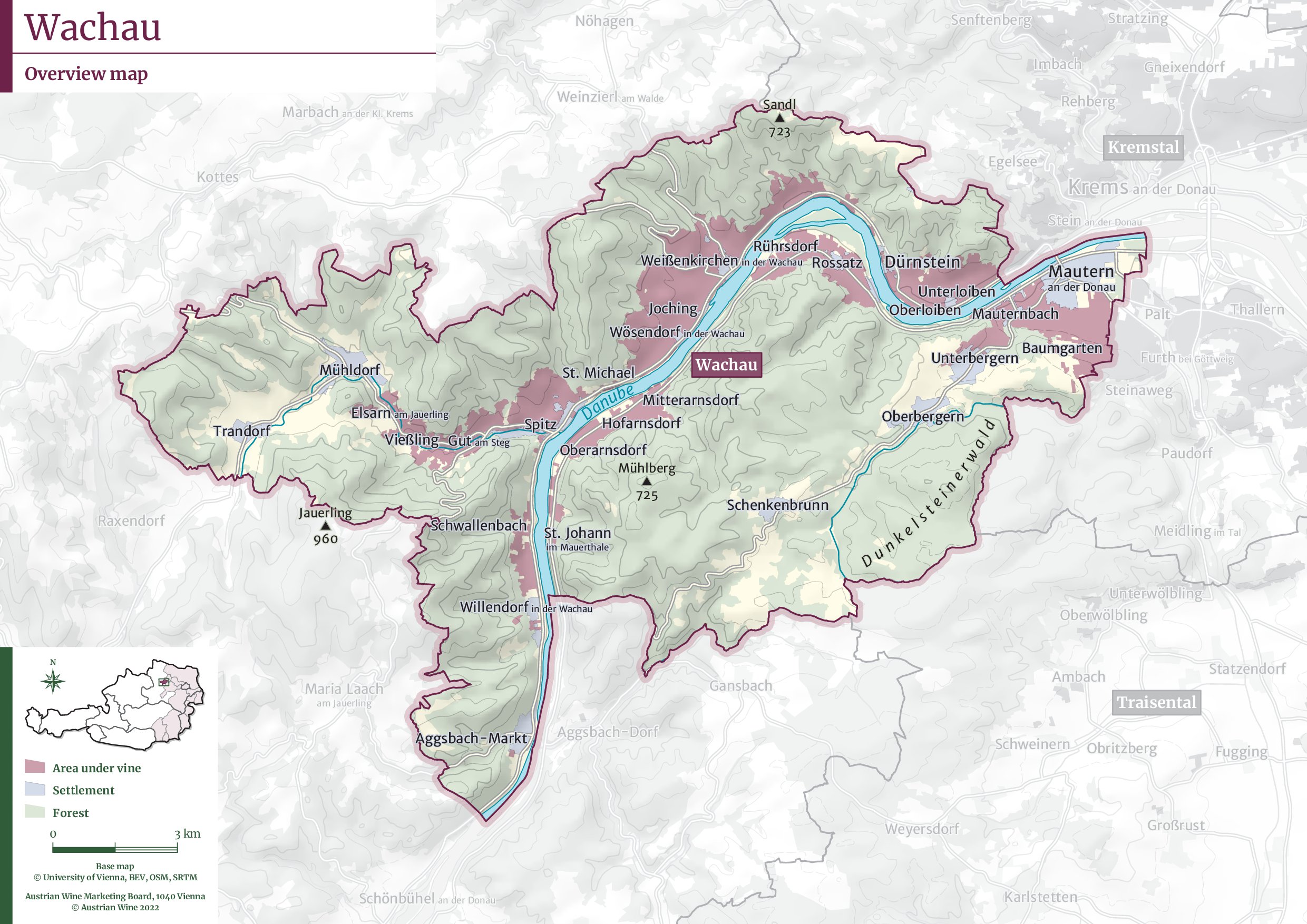
"Wachau Map (©Austrian Wine)"
Wagram
Wagram is home to world’s first school of viticulture - the Höhere Bundeslehranstalt für Wein- und Obstbau (Federal College for Viticulture, Oenology and Fruit Growing) - founded in 1860. The school is in Klosterneuberg, where one of the largest and oldest privately owned wineries in Austria is located – the famous Klosterneuburg Abbey. With its close proximity to Veinna, the region is a popular destination for weekend getaways, visiting family-run Heurige taverns.
For the most part, Wagram vineyards are planted to alluvial, gravel soils and sedimentary marine deposits, covered by loess. In 2021, Wagram became yet another DAC and at the regional level, it allows an array of grape varieties, from standard Grüner Veltliner and Riesling to Roter Veltliner, Sankt Laurent, Pinot Noir and Zweigelt. The top of the origin pyramid allows for use of Grüner Veltliner, Roter Veltliner and Riesling only.
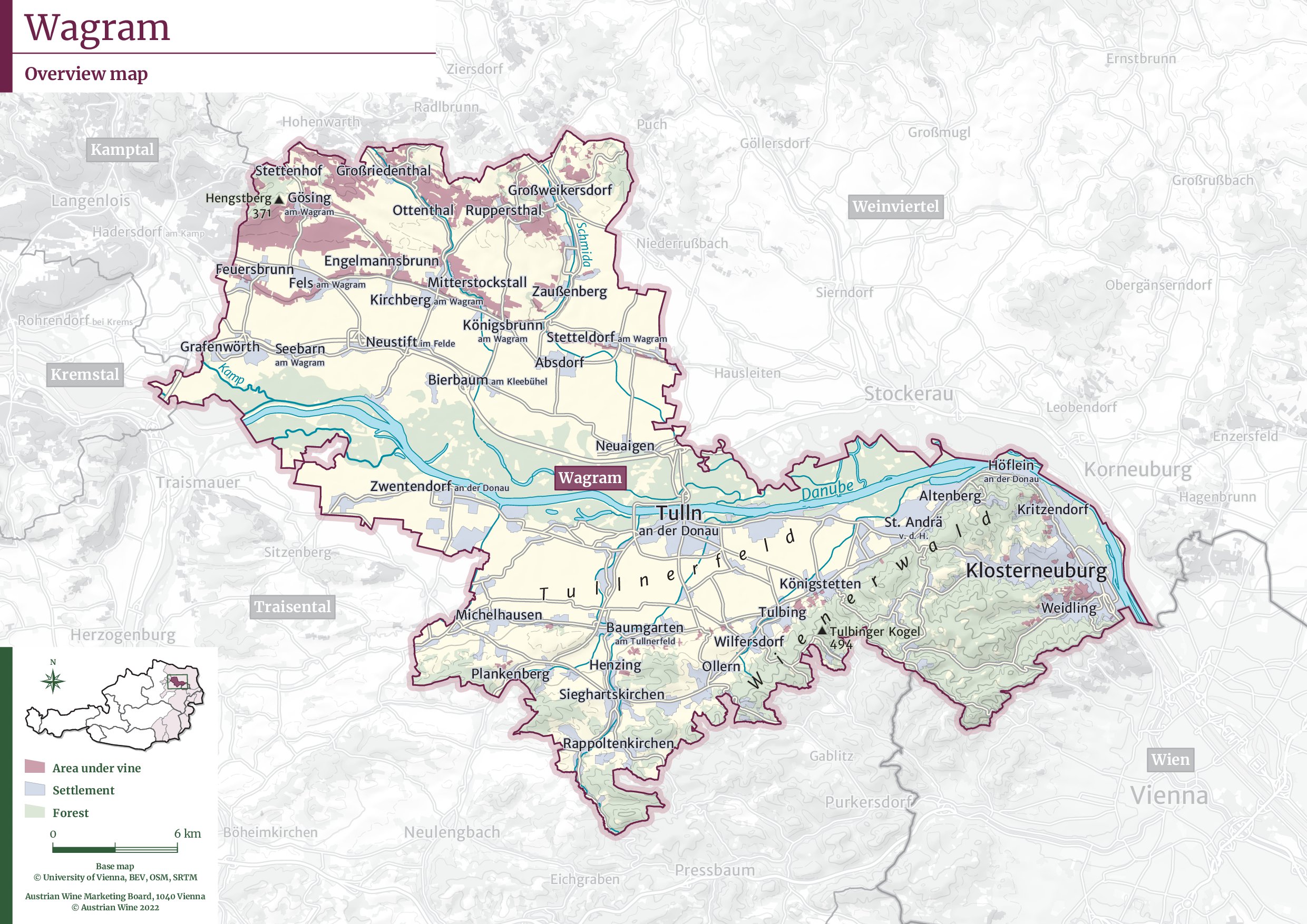
"Wagram Map (©Austrian Wine)"
Weinviertel
Weinviertel literally means “Wine Garden”, which is pretty suitable for Austria’s largest specific wine-growing region with over 14,000 hectares. It extends from the river Danube in the south to the Czech border in the north, and from the Manhartsberg ridge in the west to the Slovakian border in the east. The region is so vast and diverse that it can be divided into three different subregions.
The western Weinviertel is characterized by the dry microclimate more suited for red wine production, although around the town of Röschitz, granite soils and primary rock enable Grüner Veltliner and Riesling to shine. Winegrowers in the northeastern part of region, mainly produce spicy Grüner Veltliner, along with fresh Welschriesling and rich Pinot whites. Just north of Vienna, vineyards are notable for spicy Riesling wines, while in the southeast, where Pannonian climate is prominent, there’s an array of varieites from rich Veltliners, to Riesling and Pinots, to aromatic Traminer varieites as well.
Despite its diversity and complexity, Weinviertel was the first region to adopt the DAC standards. Furthermore, althgouh there is a hodgepodge of grapes here, Grüner Vetliner is the king, with over 7,000 hectares planted here (this represents about half of the entire countries plantings of the variety).
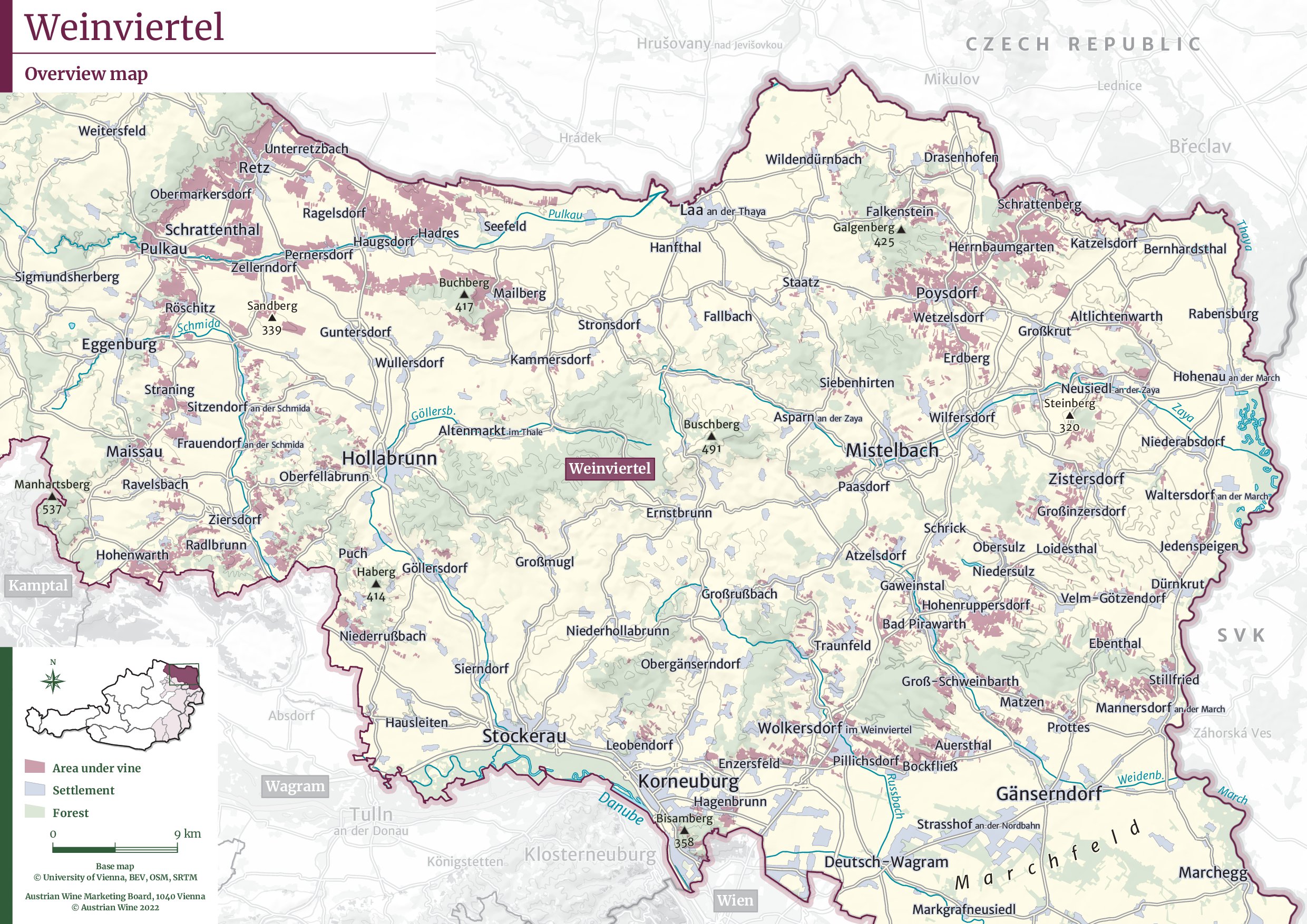
"Weinviertel Map (©Austrian Wine)"
Burgenland
Burgenland is probably one of Austria’s most dynamic regions. Ever since the early 1990’s, the region has been the main spot for innovation and experimentation. The trailblazing attitude of the winegrowers has brought Burgenland to the world fame, first with bold reds from international varieties, then with its dedication to Blaufränkisch. Finally, in more recent years with alternative style to winemaking and holistic approach in vineyard management, Burgenland has been at the forefront of the natural wine movement in Austria
Its history has also been interesting, as Burgenland was a part of Hungary until 1921 when a lot changed viticulturally and certain Hungarian varieties, like Furmint, had been abandoned. To go back further, Ruster Ausbruch has been a world-famous wine for at least several centuries. However, today, Burgenland growers are writing new pages of wine history books.
Following the release of Burgenland’s first regionally typical wine ( Mittelburgenland DAC , with the 2005 vintage), other regions have also achieved DAC recognition: Leithaberg DAC , Eisenberg DAC and Neusiedlersee DAC. Since then, the former Großlage (large collective vineyard site) of Rosalia was awarded its own DAC in 2018, together with the Ruster Ausbruch DAC in 2020, making Burgenland’s DAC family finally complete.
Burgenland’s soils and climatic influences are complex, but are mostly marked by the warm Pannonian climate, with influences of Lake Neusiedl, as well as the Styrian climate in the south. Most of the area used to be covered by sea in ancient times and the Leitha Range was the coast. This makes up an interesting mix of soils, from limestone and slate to gravel and loam, to green schist in Eisenberg. For this reason, Burgenland has it all, from light, zesty whites, to powerful reds and sweet wines, thanks to the botrytis that thrives around the lake.
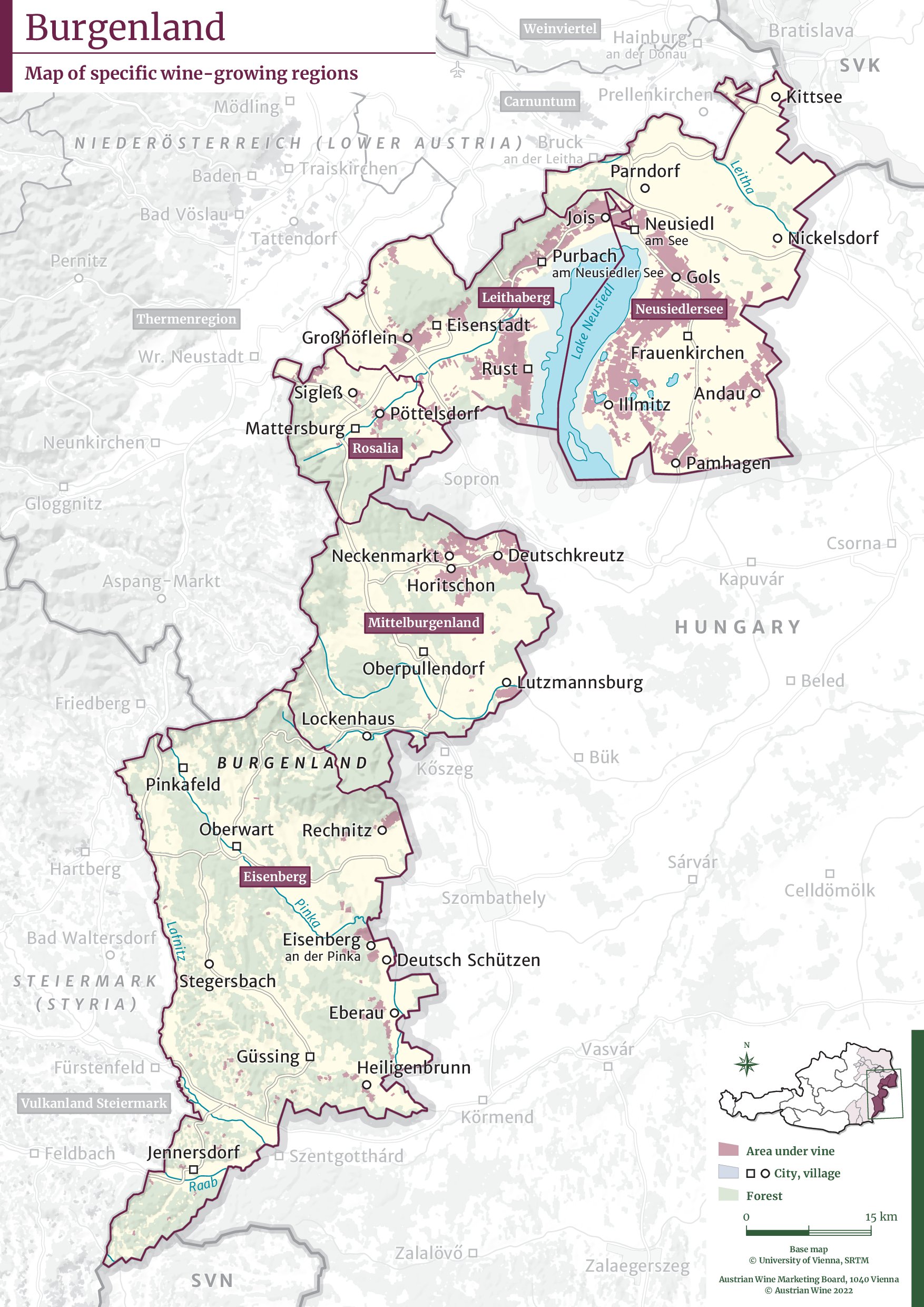
"Burgenland Map (©Austrian Wine)"
Steiermark
Winegrowing in Styria is mostly centered around the center of the state and it can be divided into three distinctive subregions which in 2018all achieved DAC status: Vulkanland Steiermark DAC, Südsteiermark DAC and Weststeiermark DAC. Each more beautiful than the other, these regions are characterized by a picturesque, green and hilly landscape.
Styria is rich in limestone, with pockets of volcanic soils in Vulkanland Steiermark, but also schist found on the Sausal mountain. Each region has its specialties, but the region as a whole is a home to some of the world’s best Sauvignon Blanc and Chardonnay (locally known as Morillon) wines. In Weststeiermark though, Blauer Wilbacher is a prominent variety that is used for a dazzling rosé wine that can hardly be copied anywhere in the world.
The most widely planted Styrian grape variety is Welschriesling, and in the right hands, this rather humble variety, can achieve great heights.
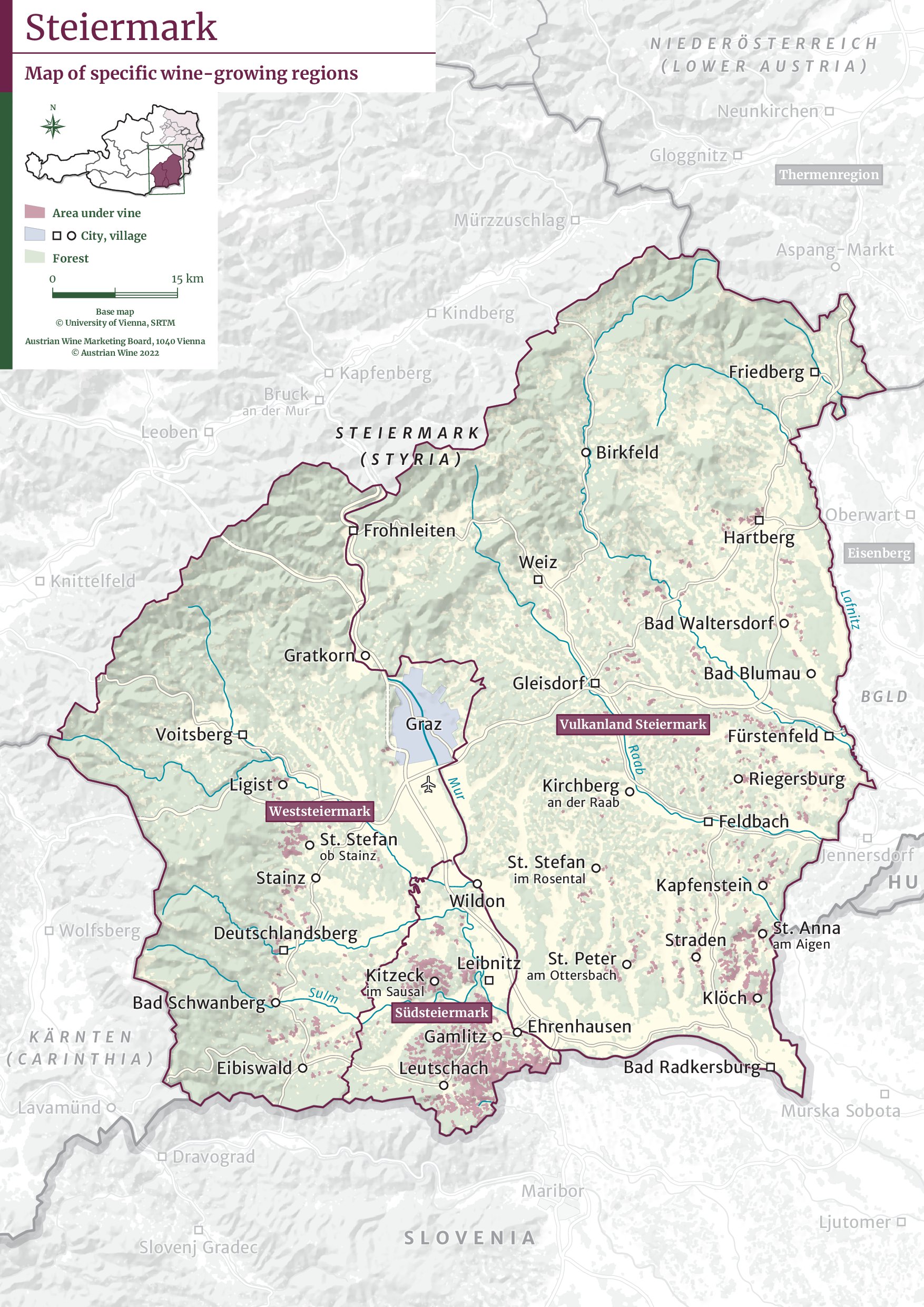
"Steiermark Map (©Austrian Wine)"
Wien (Vienna)
The capital city of Austria is probably the only city in the world that really has vineyards planted within the city itself and not only on the outskirts. As a matter of fact, the Viennese vineyards have played a key role in the local economy at least since the Middle Ages and today they help preserve the green belt that surrounds the city.
The special type of wine produced in Vienna is the Wiener Gemischter Satz (field blend) and it was added to the list of Austrian DAC wines in 2013. Nearly all winegrowers this wine, in which different grape varieties are grown together in the same vineyard, are harvested at the same time and turned into a single wine. In 2008, Wiener Gemischter Satz was added to the list of Austrian products in the Slow Food “Ark of Taste” catalogue.
The regulation regarding Wiener Gemischter Satz DAC stipulates that at least three white Qualitätswein grape varieties must be interplanted together, while the greatest proportion of any one grape variety must not exceed 50 percent, while the third largest proportion must represent at least 10 percent.
The most unique part of the Wien wine region is the Heurige culture, which are wine taverns dedicated to serving food by the growers where they can also serve and sell their own wine. This culture dates back several centuries and it was added to Austria’s list of UNESCO intangible cultural heritage in 2019. From the Heurige that are open year-round, with warm fare and a large buffet, to the small Buschenschank taverns that pop up for a several weeks a year in the vineyards themselves, this is something that every person living or visiting Vienna must experience.
Due to the great cultural significance and in order to preserve the city’s vineyards as natural and cultural landscapes, a Viennese state law stipulates that all existing vineyards must continue to be cultivated as such, thereby protecting valuable viticultural land from falling under real estate development.
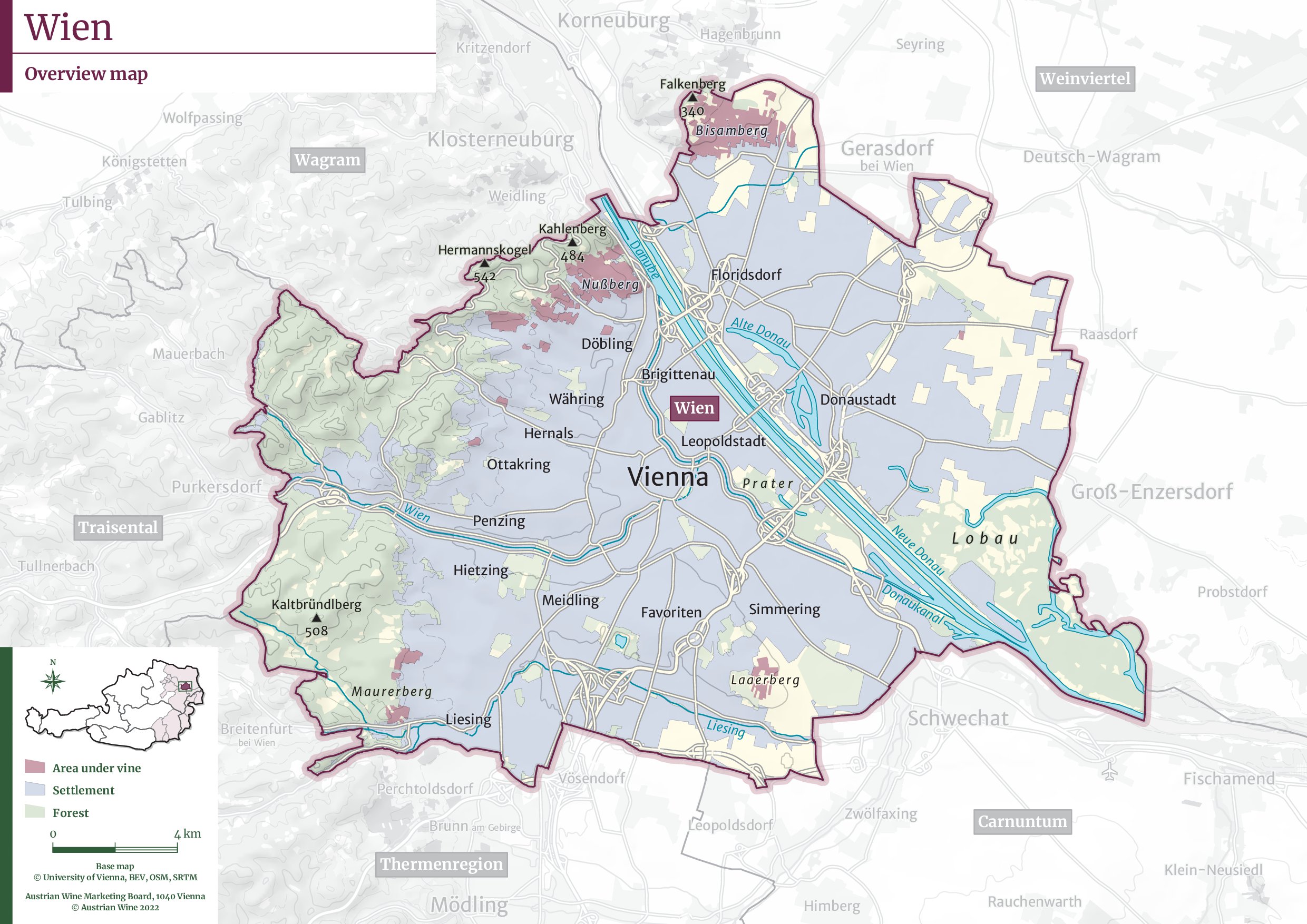
"Vienna Map (©Austrian Wine)"
Latest News in Austria
The Austrian government adopted the Wine Law Collective Decree, establishing a legal precedent for the official classification of Austria’s single vineyards. The law differentiates sites into Premier Cru or Erste Lage, in German, and Grosse Lage, which stands for Grand Cru. The inaugural wines labeled with the classifications will likely debut in 2025.
This is the first nationwide classification of vineyards, outside of France. Overall, it took nearly 30 years of research and working out the foundation before pushing for the official classification. Developing the legal classification for DAC wines was the first step. The acronym “DAC'' stands for Districtus Austriae Controllatus and is the legal abbreviation given to an Austrian quality wine (Qualitätswein) typical of its region. The DAC established a system similar to that of Burgundy, recognizing regional wines (Gebietswein), village wines (Ortswein), and single-vineyard wines (Riedenwein or Rieds)–now making it possible to distinguish between Erste Lage and Grosse Lage for the Rieds.
The classification adheres to a strict list of criteria. For instance, Erste Lage and Grosse Lage are only for DAC wines from classified vineyards. Furthermore, the wine-growing region from where the wine originates must have defined the three established DAC levels. Finally, the highest classifications are exclusively for hand-harvested wine, meeting a lower maximum yield per hectare than the legal limit.
If a region wants to classify its vineyards, its designated Wine Committee must apply to the National Wine Committee for each Ried. The application must include facts, such as historical significance, homogeneity of the soil that dominates the Ried, climate, and orientation, and the volume and value of the wines that the Ried produces. National and international wine ratings also factor into consideration. Finally, for a Ried to receive the designation of Grosse Lage, it must have been an Erste Lage for at least five years, and further requirements for using the term Grosse Lage will have to be defined.
Single vineyards (Crus):
www.austrianvineyards.com
Our latest stories and podcasts:

PODCAST EPISODE
Theresa Olkus of the VDP
Aleks Zecevic interviews Theresa Olkus, the managing director of the VDP
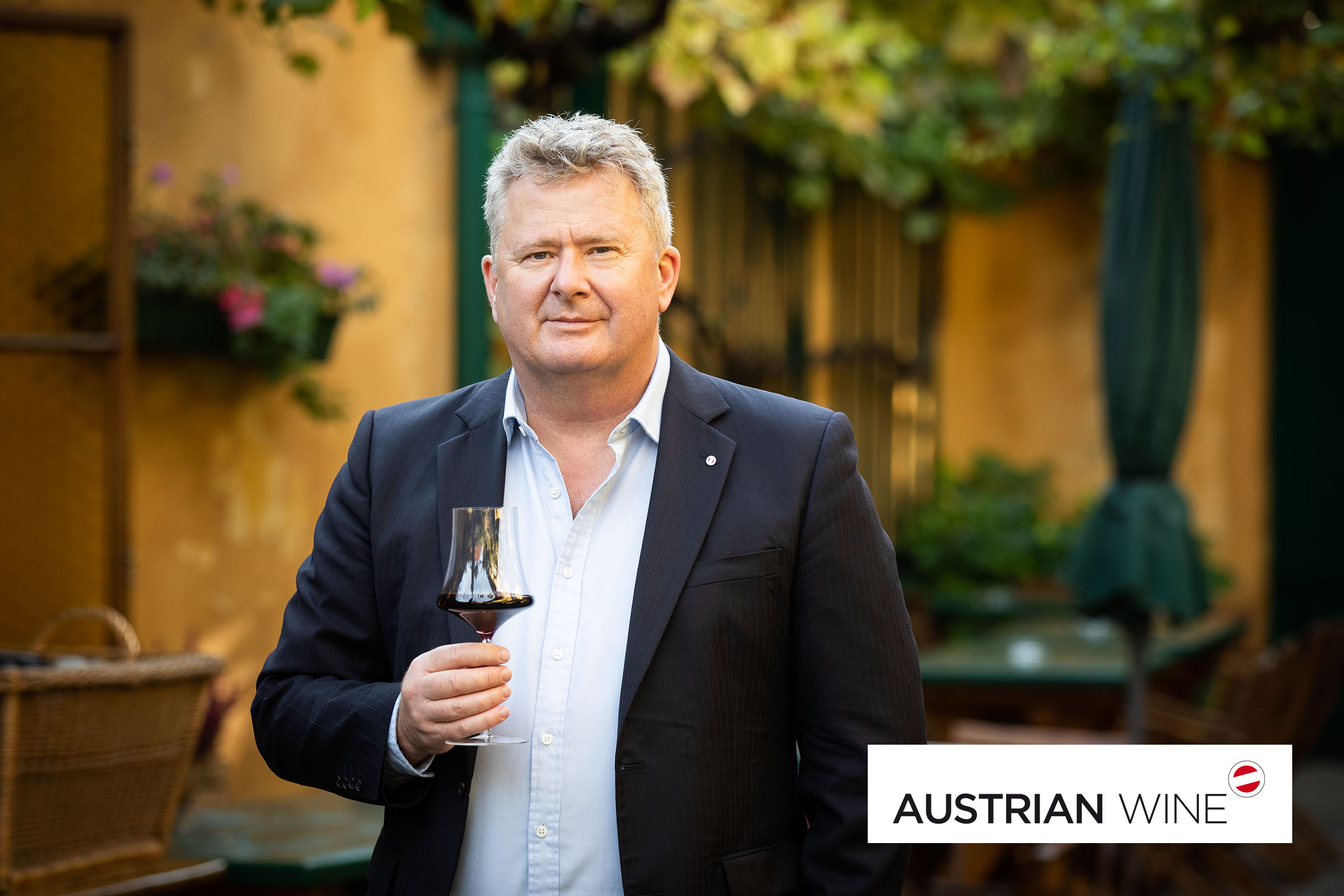
PODCAST EPISODE
Austrian Wine with Chris Yorke
Aleks Zecevic interviews Chris Yorke, CEO of Austrian Wine

PODCAST EPISODE
Treading the Grapes with Simon Woolf
In this episode, Aleks Zecevic interviews the Amsterdam-based wine writer, Simon Woolf

